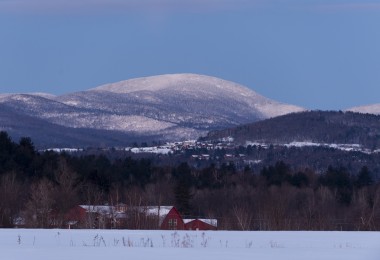Winter 2012/13 lingered late in western Massachusetts, providing me with the chance to try out my new pair of Faber Winter Guide snowshoes.
Snowshoers in southern New England need floatation atop powdered, wet, or crusted snow as well as traction for the hilly terrain. Traditional snowshoes come through with great floatation but lack the traction provided by metal frame snowshoes equipped with crampons. Crampons are deadweight in powder, though, and contraindicated in wet snow, where they fill full of a fist-sized ball of packed crud in short order.
The Winter Guide model is a hybrid of traditional and metal frame snowshoes that works as a nice compromise under these conditions. It has a wooden frame which works nicely to avoid the build-up of wet snow and to avoid punching down through crust. It has some traction but not too much. The traction comes via the series of knobs molded as part of the copolymer decking (a few are also integrated into the binding) as well as a copolymer bar set onto the underside of the crossbar.
20 March 2013 – Taconic Crest Trail segment from Petersburg Pass
A winter mix had transitioned to snow in western Massachusetts during the evening and night of March 19th before slacking off just before dawn. It picked back up as cold rain and sleet in the mid-morning in the valleys, so I decided to head up higher to check the conditions. I took the Mohawk Trail across the Mass/New York state line to park at Petersburg Pass and head southwest on a segment of the Taconic Crest Trail. Sure enough, the wintry mix turned increasingly to snow as I climbed to the parking area. I strapped into my Winter Guides for the first time—or ratcheted in, to be more precise, as the bindings feature a convenient dual ratchet closure system—and set off.
The snow conditions were fairly powdery and I found that the 10×36 snowshoes to float not quite as well as a pair of tightly-laced traditional snowshoes but certainly better than any metal frame model I have ever used. I gained about 400 feet over the course of about 0.7 of a mile, with the depth of the snow increasing along the way. There were a couple of steep sections where I felt the need to herringbone a bit and I kick-stepped a time or two when the going got even tougher, but over all the Winter Guides climbed great. The snow was blowing fast and furious when I reached a branch in the trail. It was just around noon and I decided to turn around and head down to Williamstown to unpack my lunch and dry out just a bit.
20 March 2013 – The Dome
After lunch I headed just across the Vermont state line to make an assault on the summit of the peak known as The Dome. The snow was thin at the trailhead at 1,000 feet so I stowed my snowshoes on my pack. It did not take long for me to strap them on, however, as the thin snow overlaid thick ice and I felt the need for the traction.
The trail to the summit of The Dome gains 1,700 feet in 2.7 miles. Given the unconsolidated snow conditions you might imagine that a lot of sweating was involved! There are no vistas along the way or at the top, but the summit area is covered with a spruce-fir forest.
The Mountain Guides performed admirably. They did not float as well as my 16×30 traditionals, but the 10″ width saved me some energy expenditure via improved stability while climbing and descending canted trails.
21 March 2013 – Roaring Brook/Stony Ledge loop at Mt. Greylock
The vernal equinox found me at Mount Greylock State Reservation, one of the Commonwealth’s best bets for snowcover. I started from the Mount Greylock Ski Club parking area and ascended via the Roaring Brook Trail, 1.5 miles up with nary a flat spot until the top! I noted two things about the Winter Guides on the way there. First, the placement of the bindings puts enough weight behind the crossbar that the nose pivots up easily and naturally while climbing. Second, the floatation rocked on wind-packed drifts. The couple of barebooters who had preceded me had been up past their knees in these drifts but I barely compacted the snow at all while atop them.
I headed northwest to the Stony Ledge overlook and a peak at the cirque known as The Hopper. The view never disappoints. My descent was via the Stony Ledge Trail, an old ccc alpine ski piste.
Winter Guide photos
A few photos of some of the design features of the Faber Winter Guide model as mentioned in the preceding article.
Bibliography
Books
Burns, Deborah, Lauren R Stevens, and Leah Katzelnick. Most excellent majesty: a history of Mount Greylock. 2d edn. Pittsfield, Mass.: Berkshire County Land Trust and Conservation Fund, 2009.
Massachusetts trail guide: AMC’s comprehensive guide to hiking trails in Massachusetts, 9th edn. With two foldout maps. Compiled and edited by John S. Burk. Boston: Appalachian Mountain Club Books, 2009.
Maps
Dunlavey, Patrick. Mount Greylock. 1:30,000. Pittsfield, Mass.: Berkshire Natural Resources Council, 2001.
———. North Berkshire trails. Hiking trails of the Williamstown region including the northern Taconic Range, southern Green Mountains, and Mt Greylock massif. 1:50,000. Williamstown, Mass.: Williams Outing Club, 2011.
















Leave a Comment